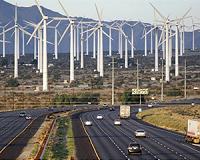 |
Manhattan KA (SPX) Mar 23, 2011 One of Kansas' most abundant natural resources may hold the key to preventing major power outages. A team of Kansas State University engineers is researching ways to use Kansas wind and other distributed energy sources to avoid cascading failures. Sakshi Pahwa, doctoral student in electrical and computer engineering, India, explored the topic for her recently completed master's project, "Distributed Sources and Islanding to Mitigate Cascading Failures in Power Grid Networks." The project was a winner at the recent Capitol Graduate Research Summit in Topeka. Pahwa's co-advisers on the project include Caterina Scoglio, associate professor of electrical and computer engineering, and Noel Schulz, Paslay professor of electrical and computer engineering and K-State's first lady. Pahwa is continuing this work for her doctoral research under Scoglio and Ruth Douglas Miller, associate professor of electrical and computer engineering. The research looks at using distributed energy sources to avoid cascading failures in power grids. A cascading failure occurs when an interconnected part of a power system fails and then triggers successive parts to fail - like the one that happened in the Northeast Blackout of 2003, a power outage that affected 55 million people in the United States and Canada. To prevent cascading failures researchers are investigating a technique called islanding, which works to minimize the impact of a power system fault to a small area. Islanding prevents this fault from affecting other areas and stops further disturbances in the network. "We used a network partitioning algorithm, and then depending on where the fault is I can disconnect that portion of the network," Pahwa said. "That disconnected portion can then be powered using renewable or distributed energy sources, such as wind turbines or solar panels, and the remaining parts are still being powered by conventional sources." The Kansas wind can potentially provide abundant renewable energy that could power the disconnected portion of the network. For data collecting and testing purposes, the researchers plan to use the university's wind turbine north of campus, near the intersection of Denison and Kimball avenues, as well as four other wind turbines installed at the Riley County Public Works Facility. The university turbine was installed for Wind for Schools, a project led by Miller, director of the Kansas Wind Application Center. The Riley County wind turbines were installed for the Resourceful Kansas project, a cooperative effort between Miller, Scoglio, Riley County and the Kansas City-based consulting firm GBA, and funded by the U.S. Department of Energy. "We need to set up power systems that are reliable and stable so that when that wind is blowing, we can use that power, but when the wind isn't blowing, there are also stable systems," Schulz said. "That's what this project is about - modeling the network so we understand the different aspects for when there are changes, when the wind blows, when it doesn't and how that affects the power system." Scoglio and Pahwa started the project when Pahwa was a master's student. As they began studying complex network systems, they turned to Schulz, a power grid expert who has done previous work with islanding. They also collaborated with power systems expert Anil Pahwa, professor of electrical and computer engineering, and Shelli Starrett, associate professor of electrical and computer engineering. "With the proper design and the right intelligence, some of the problems related to power failures can be prevented," Scoglio said. "We need to make sure that the communication network will monitor the network and detect the problem and will implement the reaction securely to implement these solutions." Sakshi Pahwa's research aims to not only study the problem from a theoretical aspect, but also provide practical solutions to real-world problems. It also fits in with the Renewable Energy Standards Act, which was signed in 2009 and states that major Kansas utilities should be able to generate about 10 percent of their power from renewable sources by 2011 and 20 percent by 2020. "This project benefits the state because it reduces carbon emissions through renewable energy," Pahwa said. "It is a good opportunity to create jobs, and renewable energy incorporation is also a support to the conventional sources so we don't need to import fuels from other countries. It helps the economy as well." Pahwa's research was supported by the four companies involved in the K-State Electrical Power Affiliates Program: Westar Energy, Burns and McDonnell, Nebraska Public Power District and Omaha Public Power District. Schulz directs the program, which supports undergraduate and graduate research programs. "This research is a benefit for Kansas and the whole nation because I think that innovation, coming from research and support from companies such as those that are part of the power affiliates, can really bring the country back to a better economic situation," Scoglio said. "Innovation comes with jobs and can really improve the whole nation."
Share This Article With Planet Earth
Related Links Kansas State University Wind Energy News at Wind Daily
 GL Garrad Hassan Announces The WindHelm Portfolio Manager
GL Garrad Hassan Announces The WindHelm Portfolio ManagerBrussels, Belgium (SPX) Mar 18, 2011 Owners and operators are under increasing pressure to reduce operational costs while improving the efficiency of their wind farm portfolios. GL Garrad Hassan has developed a new software tool to help facilitate this. WindHelm provides a single platform for the monitoring, optimisation and control of any combination of operational turbines, farms and portfolios. It gives owners and operator ... read more |
|
| The content herein, unless otherwise known to be public domain, are Copyright 1995-2010 - SpaceDaily. AFP and UPI Wire Stories are copyright Agence France-Presse and United Press International. ESA Portal Reports are copyright European Space Agency. All NASA sourced material is public domain. Additional copyrights may apply in whole or part to other bona fide parties. Advertising does not imply endorsement,agreement or approval of any opinions, statements or information provided by SpaceDaily on any Web page published or hosted by SpaceDaily. Privacy Statement |